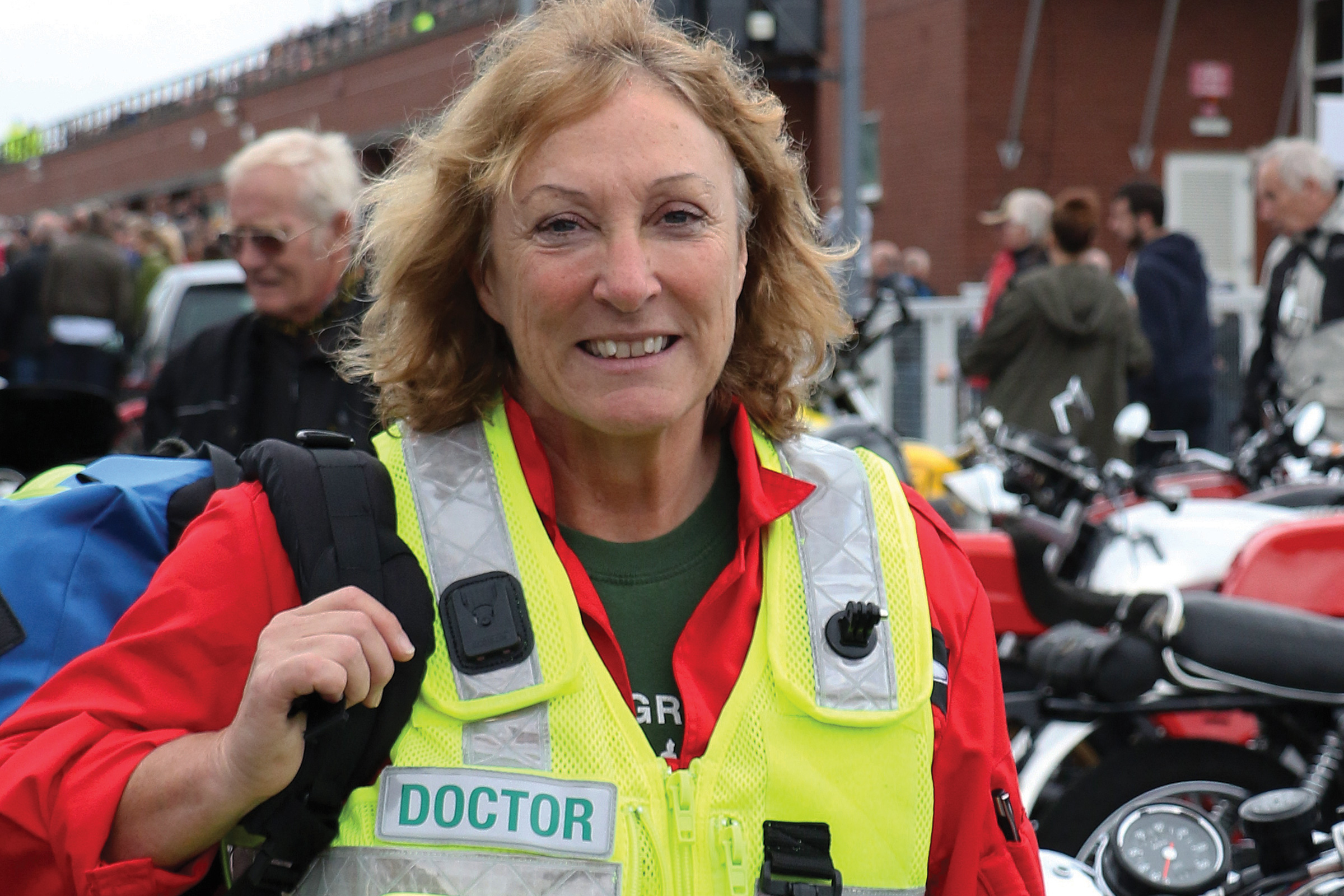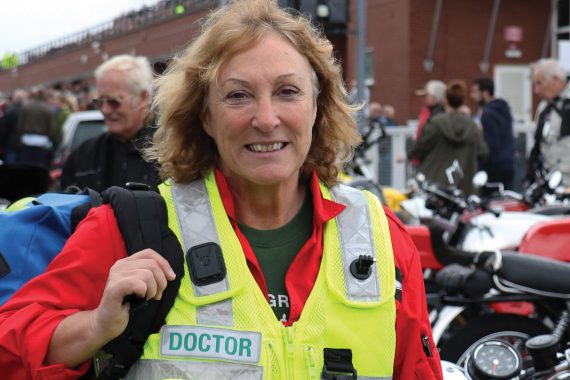Profile: Dr Sally Simmons

Age: 59
Roles: Clinical director of GP services, Island Medical Centre, Alderney; joint Chief Medical Officer (CMO) for road-racing events on the Isle of Man; diving and hyperbaric medicine doctor; pre-hospital BASICs doctor
Location: Isle of Man and Channel Islands
Hours: Average 60 hours a week during TT races, over six weeks of practice and race-day sessions each year. Average 48 hours a week as GP clinical director for nine months a year
Monday
Today I start covering the Isle of Man Classic TT, which lasts for two weeks.
At 8.00am this morning, on my way to the track, I pass the front of a long traffic queue and see a man lying face down in the road, having been knocked off his bicycle. Fortunately, when I reach him, he is talking but doesn’t want to move too much, so I do a primary survey and wait for the ambulance to arrive. My first race shift has yet to start but I’ve already helped deal with one of the many non-racing incidents that can happen on the island.
Tuesday
I am in the response car, which has the call sign Medic 1. We are called to a rider who has come off on a slow corner called Governor’s. Fortunately, he has no apparent injuries and he is keen to get back to the paddock to fix his bike. I suggest he takes paracetamol if he needs it – a classic general practice response.
Wednesday
Today I am in Race Control, at the top of the iconic tower at the TT grandstand, from where the race doctors manage incidents and feed back information to emergency services. It is not long before there’s a shout: ‘Incident at Laurel Bank.’ I grab an incident form and put AirMed, the air ambulance provider for TT racing events, on standby. The medic on scene radios through a report, explaining that the rider has collapsed, but is conscious and breathing. AirMed is scrambled to the scene and I put the helipad ambulance on standby.
Thursday
Today I am stationed at the imaginatively named Windy Corner. Marshalls tell me they know by watching a rider’s approach if he is not going to make it round. Sure enough, I can see a rider missing his apex and watch as he parts company with his bike and disappears over the side of the mountain. Once the flags are out to warn oncoming riders there is an incident, I run down the road with the paramedic to find where he has landed – some 20 feet down, on his hands and knees in a bog. We gently roll him onto his back as he is complaining of mid-thoracic pain. We keep his neck stable with a specially designed neck pillow for use with the humps that riders have on the back of their leathers. I give the ATMIST clinical handover form to the AirMed doctor and he airlifts the patient to Nobles Hospital on the island. I later find out the rider has stable fractures of C6 and T7-9.
Road-racing medicine can be shocking, especially as incidents often happen in front of you, but my GP experience has prepared me well to react to the unexpected and to remain calm, in spite my own internal panic. Also, as in general practice, having a good team and regular skills practice really makes a big difference to patients’ outcomes.
Friday
This afternoon I’m stationed at Bungalow, a mountain viewpoint where there are often hundreds of spectators. Suddenly there is a commotion in the crowd and a voice shouts for me to check on a woman. She’s in her late 60s, has no visible tattoos and is wearing an expensive-looking fleece, so she is not the average racing fan. She has fallen over and injured her ankle on Snaefell, the highest mountain on the island, and hobbled down to the track as she didn’t want to bother anyone. I splint the ankle and arrange a local ambulance to take her off the mountain. I later find out she has a fractured fibula.
I head home feeling tired but exhilarated after another eventful day on the track.
Race doctoring is hugely satisfying for me, enabling me to combine my passion for motorcyling with my professional development. It has given me more confidence in pre-hospital work – for example giving drugs for pain relief by inhalation – which I can then teach to colleagues, both as CMO and back at home.
It is also really rewarding to be part of such a great team, helping both competitors and the public to stay as safe as possible, while enjoying one the UK’s most unique and iconic sporting events.
The fee for this article has been donated to the Rob Vine Fund, set up in memory of regular TT competitor Rob Vine. The charity supplies all the medical equipment on the course as well as providing dedicated volunteer ambulance crews.

















